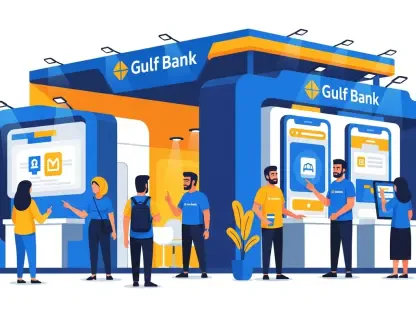In the ever-evolving landscape of personal finance, peer-to-peer (P2P) lending has carved out a significant niche, offering a seemingly revolutionary way for individual borrowers to secure funds directly from individual lenders via online platforms, sidestepping the traditional banking system altogether. This model tantalizes with promises of accessibility for those who might struggle to obtain conventional loans due to credit challenges, while also presenting lenders with the allure of potentially higher returns compared to standard investment avenues. Yet, beneath this appealing facade lies a complex web of risks that can ensnare the unwary on both sides of the transaction. Far from being a straightforward win-win, P2P lending harbors hidden pitfalls that can lead to unexpected financial burdens or outright losses. This exploration delves into the critical red flags associated with this innovative yet precarious financial tool, shedding light on the challenges that demand careful consideration before diving in.
The Borrower’s Hidden Costs
The appeal of P2P lending for borrowers often stems from its accessibility, particularly for those with less-than-ideal credit histories who might be turned away by traditional banks. However, this convenience frequently comes at a steep price, with origination fees being a primary concern. These fees, sometimes climbing as high as 8% or more, can significantly outstrip the charges associated with loans from banks or credit unions. Borrowers must meticulously comb through the terms and conditions to uncover any additional costs that could inflate the overall expense of the loan. Failure to account for these charges can transform what appears to be an affordable option into a financial burden, as the true cost of borrowing becomes apparent only after commitments are made. Vigilance in reviewing every detail of the agreement is not just advisable but essential to avoid being blindsided by unexpected expenses that erode the perceived benefits of this lending model.
Another critical issue for borrowers lies in the unpredictable nature of interest rates offered through P2P platforms. While some may secure competitive rates, especially if their credit is strong, others could face rates that rival or exceed those of traditional personal loans, ranging from 9% to a staggering 35% or more in certain cases. The annual percentage rate (APR), which encapsulates both interest and associated fees, becomes a vital metric for comparison. Complicating matters further, many P2P platforms do not offer prequalification options, leaving borrowers uncertain about the final cost until after they’ve applied. This lack of transparency can trap individuals into agreements that are far costlier than anticipated, emphasizing the need to explore multiple lending sources and compare terms thoroughly. Understanding the full scope of potential rates and their impact on repayment is a crucial step in navigating this financial landscape without falling into a costly misstep.
Challenges in Repayment Flexibility
When financial difficulties arise, borrowers often discover that P2P lenders offer far less leniency than traditional financial institutions. Some platforms are quick to initiate collection actions, sometimes within a mere 30 days of a missed payment, and may impose substantial late fees that can reach up to 30% of the loan amount. This aggressive approach starkly contrasts with banks, which might provide structured payment plans or extended timelines to help borrowers regain their footing. The rigidity of P2P repayment terms can exacerbate financial strain, pushing borrowers toward a cycle of debt that becomes increasingly difficult to escape. Awareness of these stringent policies is vital for anyone considering this route, as the consequences of even a temporary setback can be severe and long-lasting, highlighting a significant drawback in an otherwise accessible lending option.
Moreover, the lack of supportive measures during repayment challenges underscores a broader vulnerability in the P2P lending structure. Unlike conventional lenders that may offer counseling or modified repayment schedules during times of hardship, many P2P platforms prioritize swift recovery of funds over borrower assistance. This can lead to rapid escalation of penalties and damage to credit profiles, further compounding the borrower’s difficulties. The absence of a safety net means that individuals must enter these agreements with a clear and realistic repayment strategy in place, fully prepared for the possibility that unexpected life events could lead to punitive actions with little room for negotiation. Such realities demand a cautious approach, ensuring that contingency plans are considered well before any funds are borrowed through these online channels.
Lender Vulnerabilities in P2P Investments
Turning to the lender’s perspective, one of the most glaring risks in P2P lending is the potential for total loss of capital due to borrower default. The majority of these loans are unsecured, meaning there is no collateral to claim if payments cease, leaving lenders exposed to significant financial risk. This inherent uncertainty transforms what might seem like a lucrative investment opportunity into a high-stakes gamble, where the absence of tangible assets to recover losses can result in substantial setbacks. Lenders must diligently assess the creditworthiness of potential borrowers and the reliability of the platform itself, recognizing that the promise of attractive returns comes with the very real possibility of losing the entire investment. Such a precarious balance necessitates a strategic approach to mitigate exposure while navigating this alternative investment space.
Beyond the threat of default, lenders face additional uncertainty due to the lack of Federal Deposit Insurance Corporation (FDIC) protection for P2P loans. Unlike traditional bank deposits, which are safeguarded against institutional failure, funds invested through P2P platforms carry no such guarantee. Should a platform collapse or a borrower fail to repay, there is no federal safety net to fall back on, leaving lenders to bear the full brunt of the loss. This vulnerability is a stark reminder of the unregulated nature of many P2P operations, where the potential for annual returns of 5% to 9% must be weighed against the risk of complete financial wipeout. Thorough due diligence into platform stability and borrower reliability becomes not just a precaution but a fundamental requirement for anyone venturing into this arena, as the absence of protective mechanisms amplifies every potential hazard.
Unforeseen Impacts on Investment Returns
Even when P2P lending appears to proceed smoothly, lenders can encounter unexpected challenges that diminish their anticipated gains, such as early loan repayment by borrowers. While it might seem advantageous for a borrower to settle their debt ahead of schedule, this action cuts short the interest earnings that lenders rely on for their returns. The premature return of principal means missing out on the full projected income, which can significantly alter the profitability of the investment. This unpredictability adds a layer of complexity to financial planning, as lenders cannot depend on a consistent stream of interest over the agreed term. Recognizing this potential for reduced earnings is essential for setting realistic expectations and constructing a diversified portfolio that can absorb such fluctuations without derailing broader financial goals.
Additionally, the fluctuating nature of returns in P2P lending reflects a broader challenge in predicting outcomes within this investment model. Lenders must contend with the reality that not all loans will perform as expected, whether due to early payoffs or other unforeseen borrower behaviors. This variability necessitates a flexible mindset, where the potential for high returns is balanced against the likelihood of inconsistent results. Building a strategy that accounts for such uncertainties, perhaps by spreading investments across multiple loans or platforms, can help mitigate the impact of any single underperforming loan. The key lies in approaching P2P lending with a clear understanding that the path to returns is rarely linear, and adjustments may be required to navigate the ebbs and flows of this dynamic financial environment effectively.
Safeguarding Against P2P Pitfalls
Reflecting on the landscape of P2P lending, it’s evident that both borrowers and lenders face a myriad of challenges that require careful navigation to avoid financial missteps. The high fees and variable interest rates often catch borrowers unaware, while the lack of repayment flexibility compounds their struggles during tough times. Lenders, meanwhile, grapple with the ever-present risk of default and the absence of protective insurance, alongside the unexpected reductions in returns from early repayments. These issues underscore the importance of thorough research and cautious engagement with P2P platforms, as overlooking these red flags can lead to significant losses for many. The experiences of those who venture into this space serve as a reminder that innovation in finance often comes with hidden complexities that demand vigilance.
Looking ahead, the lessons learned from past engagements with P2P lending offer a roadmap for safer participation. Borrowers should prioritize comparing APRs across multiple sources and scrutinize loan terms to uncover hidden costs before committing. Developing a robust repayment plan is equally critical to withstand potential financial hiccups without facing harsh penalties. For lenders, diversifying investments across various loans and platforms can reduce the impact of defaults, while a deep dive into platform credibility and borrower profiles helps in making informed decisions. Embracing these strategies can transform P2P lending from a risky gamble into a calculated opportunity, ensuring that both parties are better equipped to handle the inherent uncertainties. As this financial model continues to evolve, staying proactive and informed remains the most effective way to balance the potential rewards against the underlying dangers.









